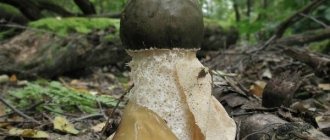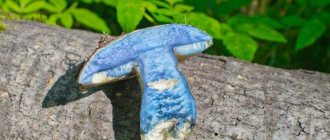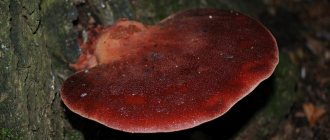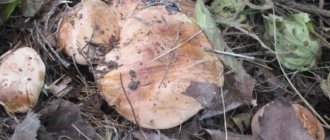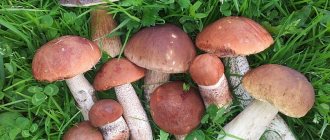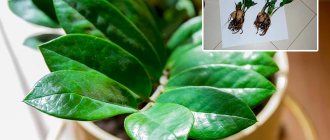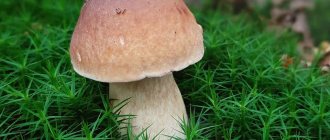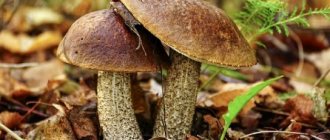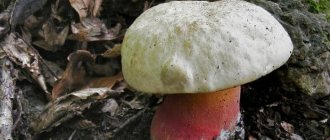Description and properties of grifola curly
Ram mushroom, curly griffola, meitake, maitake, dancing mushroom - all these are names of the same mushroom Grifola frondosa.
The mushroom belongs to the Fomitopsidaceae family.
The name Grifola probably comes from the word griffin, a mythological winged animal with the head of an eagle and the body of a lion, and the epithet frondosa means “leafy,” “covered with greenery.”
Maitake usually grows close to the ground, at the base of oaks and some other deciduous trees. Loves warm, nutrient-rich and humid places.
Grifola curly does not look like a mushroom in our usual understanding - it is not just a cap with a stem.
The mushroom has a tuberous underground part, from which a lot of highly branched legs grow, and on them grows the most important and most delicious part of the mushroom - the cap.
The caps are about 8 cm in diameter, fan-shaped, overlapping each other. Their color varies from light gray to brown. Sometimes white mushrooms are found. The lower part of the caps is covered with small whitish pores, from which the grifola releases its spores.
The total diameter of the mushroom can reach 1 meter. But usually there are specimens with a diameter of 4050 cm. Weight from 2 to 20 kilograms.
Grifola is harvested from early September to late October.
Most mycologists consider maitake to be a saprotroph, that is, an organism that lives off dead organic matter. Others classify it as a parasite.
Preparation of potions and use
From ancient times to the present day, powder made from dried grifola curly mushrooms has been used in the treatment of open wounds, cuts, and burns that do not heal for a long time. Simply sprinkle the powder onto the open wound. You can also prepare your own oil tincture.
Where and on what trees do oyster mushrooms grow in the forest?
Oil tincture
This medicine will be especially appropriate for large infected wounds. The density of the oil will thoroughly fill the entire damaged area, creating a healing film. It is very easy to make such a medicine with your own hands:
- for 250 ml of olive oil you need to add 1.5 tablespoons of dry powder;
- mix well;
- put in a dark and cool place to infuse for about half a month (the product is prepared for future use).
It should be consumed 15 minutes before meals, after shaking along with the sediment. This product also perfectly decomposes fats, so it is often used in the treatment of obesity.
Homemade tincture
It is very simple to prepare a tincture of lamb mushroom. The whole process consists of several steps:
- you need to take 5 teaspoons of powdered mushroom;
- pour 250 grams of vodka;
- mix well;
- then put it in a dark and cool place for 14 days.
Mushroom broth
For preventive purposes, you can drink a decoction of Grifola curly. You just need to pour 2 g of dried mushroom powder with warm water and let it brew overnight, then drink 100 g 15 minutes before meals. However, you should remember that you should not self-medicate. And despite the apparent versatility in the treatment of meitake mushroom, consultation with your doctor is necessary. This mushroom has virtually no contraindications; it does not harm human health.
What does an edible boletus mushroom look like?
Similar species
Grifola curly is often confused with mushrooms:
- Umbrella polypore (lat. Polyporus umbellatus) is an edible mushroom from the genus Polyporus of the Polyporaceae family. It has a lighter color than that of the ram mushroom.
- Curly sparassis (lat. Sparassis crispa) is a species of edible mushrooms from the genus Sparassis of the Sparasaceae family. Unlike the ram mushroom, it grows at the base of coniferous trees, most often Scots pine.
- Giant Meripilus (lat. Meripilus giganteus) is a mushroom of the genus Meripilus of the Meripilaceae family. Its caps are much thicker than those of the ram mushroom and the meripulus grows near beeches.
Grifola Umbrella Polyporus Umbellatus
A mushroom from the genus Polyporus, family Polyporaceae, also known as Umbrella polypore and Branched polypore.
Appearance
The fruiting body consists of many individual cap-peduncle bodies fused at the bottom. Fungi form settlements within which up to two hundred individual specimens can grow.
The hat has a slightly wavy surface, with a small depression in the center, and is painted in gray shades. Some specimens have small scales on their caps.
The hymenophore is tubular, the tubes are short and small, white or yellowish in color, extending far down the stalk. Spore powder is white or cream.
The leg is soft and thin, fused with other legs into a single cylindrical base.
The pulp is dense and white, with a pleasant taste and aroma reminiscent of dill.
Where and when does it grow
Grows from July to early November on tree roots, stumps and rotting forest floor. Sometimes it can grow on trunks high above the ground. Prefers deciduous trees - linden, maple and oak. It is very rare, but has been seen in Russia, Western Europe and North America.
Culinary use
An edible and very tasty mushroom, with delicate pulp and a pleasant smell, but only young fruiting bodies are suitable for food - in older ones, the taste and smell change greatly for the worse.
Distribution of Grifola curly
Grifola curly is very rare. It grows in temperate forests of Asia, Europe, eastern North America and Australia.
The mushroom is listed in the Red Book of Russia and is protected by the state.
Interesting! In Japan, the places where maitake grew were jealously guarded. These places were called "treasure islands." The collectors kept the secret of their location all their lives and revealed it to their eldest son before their death, so that only he would know the path to the treasure.
Where do they grow, in what forests?
The natural habitat of the maitake is deciduous forests in Asia, particularly in Japan, eastern China and the Caucasus. They are also found in some regions of the Russian Federation, as well as in North America. More often, they choose stumps and old trees as their place of “residence,” but sometimes, although quite rarely, a curly formation can be seen near a living deciduous tree.
In Southeast Asia, grifola is grown in specialized farms.
Where does it grow in Russia
It is extremely rare to see this miracle in the forests of Russia. Moreover, this species is listed in the Red Book of the Russian Federation. Single specimens can occasionally be found in the western part of the Smolensk region. By the way, inexperienced mushroom pickers may walk near the maitake and not notice it. The fact is that “lambs” easily camouflage themselves in the conditions of the space surrounding them, because often this organism looks like fallen leaves or woody growths.
The mutton mushroom lives on the stumps of broad-leaved trees
In order not to miss such a treasure in the forest, it is worth taking a closer look at the bases and stumps of deciduous trees. As a rule, griffins grow in symbiosis with larches, oaks, maples and beeches
Sometimes “lambs” can be seen near apricots or cherries.
When and how to collect
It is interesting that although this mushroom grows quite quickly, it may not appear in forests every year. The maitake growing season ranges from June to September, but experienced mushroom pickers do not advise rushing to hunt.
The best time to harvest “rams” is the beginning of autumn. Young specimens should be chosen, as older ones are fibrous and bitter. The young “bush” is carefully cut from the wood with a sharp knife so as not to damage the mycelium.
Meitake for weight loss
The history of using maitake mushroom in the fight against extra pounds has ancient origins and is not without a certain piquancy.
During the era of palace conspiracies in medieval imperial Japan, the elimination of competitors by poisoning was considered common practice. The nobles, in order not to fall victim to such treachery, first tested the food on numerous concubines, and, so to speak, ordinary feudal lords of a lower rank - on geishas. It is clear that such a diet often did not allow ladies to maintain a slim figure - and for a woman in this type of occupation, this is a direct path to professional incompetence. And, no, they should unite and organize some kind of suffragist society to combat the enslaved position of Japanese women. But, no... They obediently followed the lead of tradition and, turning to doctors and healers, found out that regular consumption of maitake mushroom allows you to maintain a slim figure, in full accordance with the canons of beauty of that time. And they began to successfully apply this knowledge in practice.
Of course, I feel sorry for the women, but their sacrifice was not in vain.
Modern beauties use their experience and use mushrooms, as well as special preparations based on these mushrooms, in order to become even more beautiful.
Doctors say that maitake contains substances that normalize metabolism and speed up metabolism.
It is believed that taking 2 grams of mushroom powder daily can relieve weight problems.
Article on the topic - Shiitake mushroom: a legend of traditional medicine.
Contraindications
- Grifola curly can cause harm due to the presence of a large amount of chitin in its composition. Therefore, overeating it is not recommended, as this can lead to stomach upset.
- For the same reason, you should not introduce dishes based on it into the diet of young children.
- Women during pregnancy and breastfeeding are prohibited from using medications based on this product, as there is insufficient information about the safety of use during these periods.
- It is better to collect this medicinal mushroom away from busy highways, industrial enterprises and big cities. The reason is the active absorption and retention of harmful substances contained in water, soil, and air.
Ram mushroom is indeed very useful, but before self-medicating, you should consult your doctor.
Meitake to boost immunity and prevent infections
Today, griffola curly is considered a very promising mushroom from a medical point of view. Researchers are especially interested in the immunostimulating properties of medicinal mushrooms. Given the fact that maitake has been successfully used in alternative medicine to strengthen the immune system and increase the body's resistance to harmful influences, it has been suggested that maitake can also help in antitumor therapy by stimulating the immune system to fight cancer.
In addition to its use in the treatment of cancer, the medicinal properties of Grifola curly are also currently being studied for the treatment of other diseases. To date, research continues on the effects of maitake against:
- diabetes;
- HIV AIDS;
- high cholesterol;
- high blood pressure.
Medicinal properties of ram mushrooms
The medicinal properties of ram mushrooms are known to many. In China, griffola curly is currently cultivated on an industrial scale as a medicinal plant. To do this, entire “hordes” of maitake are created on fruit trees, specially populated with mushrooms. When the mushrooms ripen, an extract is made from them. It is additionally purified from possible harmful impurities. The average yield is 1 kilogram of extract per 10 kilograms of fresh product.
Why is the extract made specifically? Scientists have come to the conclusion that this particular product exhibits the greatest number of positive properties of this mushroom. It is worth knowing that its capabilities are enormous. The mushroom helps in the fight against a variety of health problems.
So, the ram mushroom has medicinal properties, which are:
- improve glucose and insulin metabolism;
- provide prevention of heart and vascular diseases due to the removal of cholesterol;
- increase the elasticity of the walls of blood vessels;
- reduce blood pressure;
- strengthen immune functions, especially in the fight against cancer;
- minimize the negative manifestations of menopause, helping women normalize their own condition even in such a difficult period;
- normalize metabolic processes and hormonal levels in order to normalize and maintain weight at an optimal level;
- fight viral diseases, generating healthy cells;
- fight liver diseases, including cirrhosis;
- reduce or eliminate discomfort during and before menstruation.
In other words, the benefits of the extract are clear to everyone. It normalizes the functioning of the endocrine systems, heart, blood vessels, helps with liver diseases caused by toxins or viruses, and eliminates fungal infections. The healing power of the ram mushroom has been proven by specialists of modern medicine.
In folk medicine, extracts, decoctions and infusions are actively used. Honey extract of the ram mushroom is also used in cosmetology. In particular, this product is often included in cosmetics, helping to restore the beauty and health of the skin.
Application in medicine
The maitake mushroom is popular not only as an edible mushroom. Its unique composition and healing properties make it possible to use it in the treatment of many diseases. Dietary supplements with maitake can be bought at the pharmacy, or you can prepare the medicine at home.
Below are descriptions of medications, methods of their manufacture and use.
Extract
The extract of these beneficial mushrooms has been patented and is known as Maitake D-fraction. It is available in powder or tablet form. Manufacturers claim that maitake extract helps with:
- reduced immunity;
- metabolic disorders;
- diabetes mellitus;
- menopause;
- elevated cholesterol levels;
- hypertension;
- viral diseases;
- fungal diseases.
Maitake mushroom powder
At home, you can prepare mushroom powder by grinding dried mushrooms in a coffee grinder. It should be stored in a hermetically sealed container in a dry place.
The powder is used to prepare medicinal infusions and decoctions, and is also added to food.
Maitake tincture
3 tbsp. mushroom powder is poured into 0.5 liters. vodka, mix, close tightly and infuse for 2 weeks at room temperature. Shake before use.
Helps with:
- reduced immunity;
- high cholesterol levels;
- problems with excess weight;
- treatment of oncological diseases.
Directions for use: 1–3 tsp. 3 times a day before meals (30 minutes before). Course duration is 3-4 months.
Maitake wine
Add 3 tablespoons of mushroom powder into a bottle of dry red wine, seal tightly and keep in a dark place at room temperature. Shake before use.
Helps with:
- problems with excess weight;
- insufficient immunity;
- menopause;
- treatment of oncological diseases as part of complex therapy.
Directions for use: 1–3 tsp. 3 times a day before meals (30 minutes before). Course duration is 3-4 months.
Maitake oil
3 tbsp. mushroom powder is poured into 0.5 liters. vegetable oil (linseed, olive), mix, cover and leave for 2 weeks at room temperature. Shake before use.
Helps with:
- reduced immunity;
- problems with excess weight;
- treatment of oncological diseases.
Directions for use: 1–3 tsp. 3 times a day before meals (30 minutes before). Course duration is 3 months. After a ten-day break, the course is repeated.
Benefits and harms
We can talk about the benefits of griffola curly for hours. It is widely used in pharmaceuticals, cosmetology and traditional medicine. Medicines are prepared from the mushroom that are used in the treatment of cardiovascular diseases, liver diseases, kidney diseases, lung diseases, oncology and women's diseases. It is a good immunostimulant. Helps with colds, relieves joint pain.
This mushroom has no equal in the amount of vitamins, micro and macroelements, carbohydrates, fats and amino acids. You can see this for yourself by looking at the list below.
The pronounced beneficial properties are explained by the rich composition:
- Vitamins: B1, B2, B4, B5, B6, B9, D, E and PP.
- Microelements: iron, selenium, zinc, manganese and copper.
- Macroelements: potassium, calcium, magnesium, phosphorus and sodium.
- Carbohydrates: mono- and disaccharides, lactose and glucose.
- Fatty acids: omega-6 and omega-9.
- Amino acids: leucine, arginine, glutamic acid, lysine, clycine, tryptophan, phenylalanine, methionine, isoleucine and histidine.
There is no harm from this mushroom if you eat it wisely and use it in treatment, after consulting with your doctor. The only contraindication is children under 14 years of age, pregnant women and nursing mothers. People with gastric ulcers are also advised to use it with caution.
It is better to collect mushrooms deeper in the forest, away from highways, factories and other polluted places. Of course, it is also important to know how to properly dry collected mushrooms and cook them, but we will talk about this a little later.
Use in cooking
Meitake is traditionally popular in Asian dishes, but due to the fact that mushrooms have recently been grown industrially, they have become frequent guests on the tables of residents of other countries.
They are used to prepare soups, sauces, main courses, and they are also eaten pickled.
One of the most popular recipes is to simply fry them in oil until crispy.
Maitake can replace champignons in any recipe for a more flavorful dish.
Maitake dishes
Creamy mushroom sauce
Ingredients:
- maitake 300 g;
- onion 1 pc.;
- sunflower oil 4 tbsp. l.;
- butter 50 g;
- wheat flour 1 tbsp. l.;
- cream 300 ml;
- salt.
Preparation:
- Finely chop the mushrooms and onions and fry in a frying pan until the moisture evaporates and a golden crust forms.
- Melt the butter and mix it with flour, pour in the cream and mix thoroughly. Cook over low heat with constant stirring.
- Add the fried mushrooms, add salt and cook, stirring, for another 3-4 minutes.
Maitake mushroom soup
Ingredients:
- potatoes 3 pcs.;
- maitake 300 g;
- carrots 1 pc.;
- vegetable oil 20 ml;
- cream 100 ml;
- salt, spices.
Preparation:
- Boil peeled and chopped potatoes and carrots in 2 liters of water.
- Chop the mushrooms and onions and fry them in vegetable oil.
- Add the fried mushrooms to the pan with the vegetables, pour in the cream, add salt and simmer for 5-7 minutes.
Mushroom composition
Due to its rich chemical composition, lamb's head mushroom has many beneficial properties. Meitake composition:
- proteins – 1.95 g,
- fats – 0.18 g,
- carbohydrates – 8 g,
- dietary fiber – 2.6 g,
- water – 90.5 g,
- ash elements – 0.52 g,
- potassium – 205 mg,
- phosphorus – 73 mg,
- magnesium – 11 mg,
- calcium – 2 mg,
- sodium – 2 mg,
- zinc – 0.76 mg,
- iron – 0.2 mg,
- manganese – 0.07 mg,
- selenium – 2.3 mcg,
- copper – 0.26 mcg.
The mushroom has a rich vitamin complex:
- nicotinic acid (niacin, PP)—7.18 mg,
- ascorbic acid (vitamin C) – 2.2 mg,
- riboflavin (lactoflavin, vitamin B2) - 0.25 mg,
- thiamine (vitamin B1)—0.14 mg,
- tocopherol (vitamin E)—0.02 mg,
- calciferol (a combination of calcium and vitamin D)—28.2 mcg,
- cyanocobalamin (vitamin B12) - 0.03 mcg.
The chemical composition of meitake includes a set of amino acids necessary for the human body. This includes:
- Essential: valine, lysine, leucine, isoleucine, tryptophan, phenylalamine, threonine, methionine.
- Conditionally essential: cystine, histidine, alanine, tyrosine.
- Replaceable: proline, glutamic acid, arginine, aspartic acid, glycine, serine.
Characteristic features of the variety
The ram mushroom is different from other mushrooms. The ram has many fan-shaped caps on short legs that form a bush. It will delight the mushroom picker with its weight, which reaches up to ten kilograms, while the diameter can be 80 cm.
Appearance of the ram mushroom
Photos and descriptions of this species of mushroom give a complete picture of its unusual structure. The body looks like many fused mushrooms, the caps of which resemble leaves with jagged edges. At the same time, the legs are clearly distinguishable; they grow together into a dense bush of gray-green color.
Appearance and description of saffron mushrooms and where do they grow (23 photos)? Saffron milk caps are one of the most common mushrooms in our country. They are popular not only due to their exquisite taste,...Read more...
In the photo you can see that the ram's head mushroom grows at the roots of trees; it can also be seen on stumps. The lamb mushroom is listed in the International Red Book as it is an endangered species.
Morphology
Meitake is sometimes confused with other similar species, so you need to pay attention to its external and internal features:
- the body of the mushroom consists of a large number of small thin caps, which are attached to small legs and connected into one whole, smoothly branching;
- the cap is fleshy and leathery to the touch, the edges are uneven and wavy.
It is grayish-green above and white below; Mushroom in section - the mushroom has light flesh; it breaks easily, has a pronounced mushroom aroma and a nutty flavor;
- the spores look like white powder.
Place of distribution in Russia and other countries
Where this unusual, rare species grows, deciduous trees are most common. It is often found in China, Japan, Korea, and the northeastern United States. In Russia, it can be found exclusively in the Far East of the country and the Volga region; sometimes mushroom pickers find it in the Urals.
Eating
This species is most often consumed when it is young, when the flesh has not yet had time to darken. Mature fruits no longer have such a pleasant taste, although they themselves do not cause any harm. It belongs to the fourth category of edible mushrooms, so it is not recommended to add it to food raw, but should be boiled first.
Maitake
Mushroom pickers with extensive experience dry the ram mushroom, then grind it into powder and use it as an aromatic seasoning, which is perfect for fish dishes, meat, salads and broths. Basically, it is not used as a separate dish, but added to soups, or delicious sauces are prepared.
Rules and meeting places
The ram mushroom grows in deciduous forests and is found on stumps or near the base of a tree. Most often these are oak, maple and linden. They can rarely be found in chestnut and hornbeam. The most favorable period for collecting dancing mushrooms is August and September. They should be collected carefully, cutting them from below with a sharp knife.
Attention!
It is worth remembering that this mushroom is very fragile.
Grifola curly - edible or not
Grifola curly, the photo of which you see, has a grayish-brown color, but you can find representatives with a lighter, yellowish tint. Sheep has a unique pleasant smell and nutty taste. It is better not to try it raw in large quantities. It can be used in food in boiled or dried form. Dried maitake powder is used as an excellent dietary supplement.
The ram belongs to the fourth category. Soups and meat broths are made from it. It tastes especially delicious when fried. Like many more popular types, maitake can be pickled and jarred.
